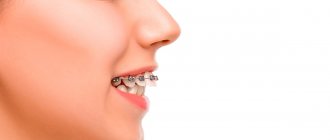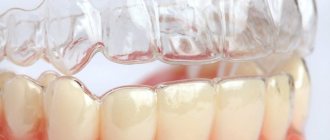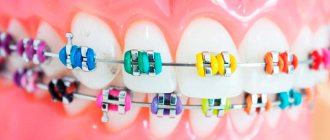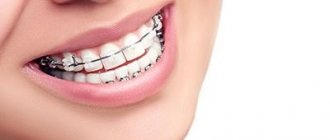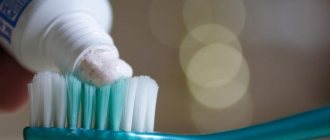Ligature braces - what are they?
This is an orthodontic design in which there is a metal bracket (arc) connected to braces-locks on the teeth. The bracket is threaded through the groove of each lock, combining them into a single system. Each lock in the ligature bracket system is attached to the arch with ligatures. They can be in the form of rubber or wire rings. The structure is installed so that the bracket determines the vector of movement of the dentition units. For adult patients, clear or white elastic bands are used. Multi-colored rubber bands will suit your child as an additional decoration.
Despite the fact that today more advanced types of braces with self-regulating elements are being produced, the classic ligature version is still popular because of its reliability. In addition, this is a less expensive correction option.
The history of bite correction goes back many centuries. The first prototype of modern types of braces appeared only in the 17th century in France: the court dentist Pierre Fauchard straightened teeth using a plate tightly tied to the dentition with strong threads. Many specialists tried to contribute to the creation of the desired design, but only at the end of the 19th century a real breakthrough occurred: the American dentist Engle created a device based on the force of an arc. Since then, the design created by Engle has been constantly improved.
How to brush your teeth correctly
Step-by-step recommendations for cleaning children's teeth with braces.
- Using a simple brush, clean the inside of the teeth and the surface of the back teeth, paying attention to the fissures.
- The frontal area of the dentition, on which the structure is located, is cleaned with an orthodontic brush. Movements with such a brush should be performed slowly, without strong pressure in the horizontal direction. Clean tooth enamel, plates and clasps with a brush.
- Holding the brush at an angle of 45° clean the interdental line. Movements are performed in a “comma” pattern to eliminate all deposits.
- To clean the surface of the teeth under the metal arch and structural elements, use a mono-beam brush. Paste is applied to the bun and placed under an arch.
- Hard-to-reach areas are cleaned using a brush. The instrument is placed under the arc and rotated, performing translational movements.
- Using an irrigator, the remaining deposits are removed and the gums are massaged.
- To thoroughly clean the interdental space and other hard-to-reach areas after the irrigator, use dental floss.
The duration of brushing teeth for children with braces takes 15 minutes. The procedure is carried out 3-4 times a day after each meal. Classic teeth cleaning is not enough, so every 4-6 months it is recommended to contact your dentist for a professional procedure.
Who is suitable for ligature braces?
When carrying out treatment, the orthodontist conducts a preliminary examination of the patient, after which he analyzes the data obtained and decides on the possibility of installing braces.
Installation of ligature braces is indicated for:
- various malocclusions;
- crowding and curvature of units of the dental system;
- the presence of large gaps between teeth – diastema and three;
- impacted or unerupted teeth due to lack of space – promotes the movement of teeth and their normal eruption;
- violation of the facial contour due to various anomalies of the dental system;
- atrophy of the jaw bone and reduction of interdental spaces in preparation for prosthetics or implantation.
Contraindications are divided into absolute and relative. The absolute ones include:
- severe osteoporosis - fragility of bones due to the loss of bone tissue minerals, especially calcium;
- decompensated (with unstable blood sugar) diabetes mellitus;
- congenital and acquired (AIDS) immunodeficiencies;
- bone tuberculosis;
- edentia – toothless jaw;
- bruxism;
- oncological processes after radiation or chemotherapy;
- severe psychoses.
Relative (eliminable) contraindications:
- chronic periodontitis and periodontal disease in the acute stage;
- caries and its complications;
- any acute and exacerbation of chronic pathological processes.
Installation and removal
It is possible to make your smile more graceful even with existing braces. To fix the colored elements, you do not need to remove the entire device. They can be easily put on special point elements of the device. The rubber bands are installed in just a few minutes.
First, a dental expander is installed, then the teeth are polished and dried, applying locks and staples to each of them using special glue. Next, they are fixed with a metal arc.
Procedure for installing ligatures:
- separate the lining from the retainer using a clamp;
- put rubber material on the bracket;
- check with pliers to see if the fastening is secure.
Metal elements take much longer to install, since the dentist must additionally twist the wire to achieve the desired shape. At the end of the procedure, the tip is cut off with a special tool that resembles a wire cutter.
The device for straightening teeth and normalizing the bite can sometimes be removed (for professional teeth cleaning, arch replacement). To remove the device, use a certain liquid that dissolves the glue that fixes the elements. The staples are dismantled, cleaned and adjusted. If it is necessary to install an updated bracket system, then new ligatures are applied.
At what age do children get braces?
Fixed orthodontic systems are usually installed when all the molars have erupted, with the exception of the third molars (eights) - at 11-14 years. At this age, the entire set of units grows, but the tissues are still pliable and mobile, the formation of jaws and facial features continues.
Puberty is the most optimal period for correcting malocclusion. At this time, it is important to form a normal occlusion, correctly distribute the load between the teeth, and ensure the organic development of the jaws and temporomandibular joint (TMJ).
But at this age, what matters most to children is their appearance, relationships with peers, and the opinions of others. And braces are considered something disfiguring. Therefore, bright, colorful systems are very relevant among teenagers: they help overcome psychological comfort, turn designs into their feature or part of their image.
Pros and cons of ligature braces
Advantages:
- correction of anomalies of the dental system of increased complexity: ligatures give the system additional strength and reliability;
- the ability to change the types of ligatures according to the patient’s choice; colored ones are especially suitable for children, white and colorless – for adults; rubber ligatures can be replaced with wire ones;
- the possibility of frequent monitoring of the treatment process with changes in specified parameters;
- reasonable price and wide selection of prices.
Flaws:
- lengthy process of installing ligature braces;
- the system is bulky and noticeable on the teeth;
- transparent and colorless ligatures quickly turn yellow from food coloring and take on an unaesthetic appearance;
- the need for monthly visits to the orthodontist to monitor and correct treatment;
- frequent complaints from patients about irritation of the oral mucosa with ligatures, which helps to lengthen the period of adaptation to the system; after changing the ligatures, the patient may feel pain for some time;
- it is more difficult to carry out hygiene procedures.
Why is it necessary to replace colored ligatures?
The elastic bands that attach the arch to the braces tend to wear out and stretch quickly. This applies to both regular and colored ligatures. If the elastic band weakens or breaks, it can no longer effectively hold the archwire, and the latter ceases to fully perform its main function - to put pressure on the teeth in order to move them. Therefore, patients who wear ligature braces will have to visit the orthodontist every 3-4 weeks for correction and replacement of ligatures.
For those who wear colored braces, such frequent visits to the doctor have their advantages. You can regularly change the color of the rubber bands and look new every month.
Types of models with ligatures
Designs from different manufacturers may differ in material of manufacture and location of attachment.
Braces made of various materials
Below are comparative characteristics of various models.
Metal ligature braces
Braces made of metal alloys
The main advantage of metal braces is that they are suitable for correcting bites of any complexity. They are reliable, but bulky and not very attractive in appearance, which is why they are preferred for children. World leaders in the production of such systems are trying to smooth out the shortcomings by releasing smaller models with a light Teflon coating and, accordingly, with a higher price.
- Pros: durability, high therapeutic effect and low price.
- Disadvantages: irritation of the oral mucosa, pain during the adaptation period, unaesthetic, cheap models containing nickel may cause allergies.
Ceramic ligature braces
Ceramic braces
Ceramics are very similar in appearance to tooth enamel. It does not produce glitter and blends with natural crowns, creating an invisibility effect. Dental ceramics are a very durable, but rather fragile material. Ceramic braces do not injure the mucous membranes, so the adaptation period is quick and easy.
- Pros: look beautiful, minimal risk of injury, lightweight, comfortable, biocompatible.
- Cons: less reliable than metal ones, can break and be stained with dyes, have a higher price.
Sapphire ligature braces
Sapphire braces
Made from artificial sapphires. They are transparent, shimmer and look very beautiful. Sapphire braces are not suitable for correcting all defects: their low strength lets them down.
- Pros: aesthetics, no staining, hypoallergenic, short adaptation period.
- Disadvantages: low strength and reliability, in the absence of high-quality hygiene, clouding is possible, high cost. Due to fragility, not suitable for children. Read here which system is best for your child.
Plastic
Plastic transparent braces
These are visually very attractive systems made of medical plastic with hypoallergenic properties. They are white in color, invisible on the teeth, but are not highly reliable, so they cannot be used to correct serious defects in the dental system. Prices vary depending on the quality of the product and the manufacturing company.
- Pros: aesthetics, complete biocompatibility, lightness and ease of wearing.
- Cons: fragility, frequent breakdowns, dark colors, especially when smoking.
Combined
Combined (ceramics on the front, metal on the sides) braces
To increase functionality and aesthetics, and reduce cost, combined structures are installed. To do this, locks made of ceramics, sapphires or plastic are installed on the front, and metal on the sides.
At the location of attachment
Based on this feature, structures are divided into two types - vestibular and lingual. There are significant differences in the installation features of these models.
Vestibular and lingual models
Vestibular type structures
These braces are considered classics. They are attached to the sides of dental crowns facing the inner surface of the lips and cheeks. Such structures are easier to install, they cause less trauma to the mucous membrane and almost do not cause problems with diction during the adaptation period. Metal models of this type can be used to eliminate serious defects.
- Pros: stability, ease of installation, treatment time is shorter than with lingual ones.
- Cons: unaesthetic.
Lingual braces
These are more modern designs. The difference is that lingual braces are attached to the inner, tongue-facing side of the dental crowns. Outwardly they are invisible, but less convenient to wear and install. They have a fairly long adaptation period, as they often injure the tongue and affect the clarity of speech.
- Pros: invisible when smiling, wearing them does not cause psychological discomfort.
- Disadvantages: they often cause pain, discomfort and speech impairment, it is impossible to treat serious disorders, they are much more expensive than vestibular ones.
Color selection
When choosing color designs, you must be guided by the following points:
- Own wish. This category includes favorite shades, colors of state symbols, color combinations of holidays (monthly change of ligatures allows you to change them according to the seasons) or favorite sports team.
- Color of eyes, skin and hair. Different shades look different on brunettes, blondes or people of different races. Designs that match the patient’s eye color look impressive.
- Wardrobe. If the clothes are designed in approximately the same color, then colored designs to match them would be a good solution.
- Enamel color. Colored structures can visually make the surface of the teeth more attractive, and vice versa.
Popular brands of ligature braces
Brand systems Alexander, Clarity
Global manufacturers are releasing more and more new lines of brands that have differences in design. The most famous and popular brands:
Alexander (Ormco, USA) – metal ligature bracket system made of high-quality steel; a very popular model with narrow locks; the design is effective in treating any anomalies, comfortable to wear: the adaptation period is quick and painless; the price is high.
Clarity Advanced (American company 3M Unitek) - made of high-quality durable ceramics; the locks are small and do not create problems during the adaptation period; patients are always satisfied with the aesthetic appearance of the structure; average price category.
Brand Inspire ICE
Inspire ICE (Ormco, USA) – a very beautiful, transparent model that shimmers when illuminated; durable, but also fragile, like all sapphire structures; The disadvantages are increased fragility and high price.
Radiance (American Orthodontics, USA) - made of translucent sapphires, almost indistinguishable in color from tooth enamel, therefore completely invisible when smiling; expensive models.
Pumo (Ortho Technology, USA) – made of sapphires treated with zirconium, which gives the model additional strength; the cost is lower than previous models.
Spirit MB (American company Ormco) - models made of plastic on a metal base; light, beautiful, comfortable; the disadvantages are a possible change in color and insufficient strength, and therefore the design is used to eliminate simple defects; quite expensive, but the best model in its segment.
Plastic braces from Ortolite, Russia are of lower quality than the previous ones, but they are light, beautiful and inexpensive models.
Why do you need colored rubber bands for braces?
From a practical point of view, there is no difference between transparent and colored ligatures.
Multi-colored rubber bands play the role of a kind of anti-stress. They transform the bulky structure on the teeth, which many teenagers and adults are embarrassed about, into a stylish playful accessory. It looks fashionable, bright, and no one would dare to bully or tease a teenager who wears such braces. First of all, because he himself feels more confident in them. Colored ligatures made of elastic material make it easy to disguise the ugliest and protruding parts of the brace system, hiding them behind a bright rubber ring. Some manufacturers went even further and began to make ligatures not only of different colors, but also of original shapes - in the form of hearts, flowers, diamonds. This allows, with the help of a brace system, not only to correct orthodontic disorders, but also to show your individuality. That is, green, black or pink braces are both a medical device and a decorative decoration for the teeth.
Advantages of multi-colored braces:
- Teenagers wear them with great pleasure and feel less complex.
- Colored elastic bands, unlike transparent ones, do not stain and look aesthetically pleasing throughout the entire period of wearing.
- The cost of colored braces is almost the same as the cost of classic braces, which will help you save your budget.
- Elastic bands for braces are made of medical material, they are hypoallergenic and harmless.
- Colored braces allow you to look unique and at the same time correct existing malocclusions.
Installation of ligature braces
Installation is carried out in stages:
The first stage is diagnosis. The patient is prescribed laboratory and instrumental tests: general and biochemical blood tests, blood clotting tests, plain radiography of the jaw, computed tomography (CT). The patient is also sent for a consultation with a dental therapist.
The second stage is sanitation of the oral cavity in case of detection of pathology. Treatment of caries and its complications, gum diseases, etc. is carried out. After this, the dentist performs professional oral hygiene, removes soft and hard plaque, and polishes the enamel. The orthodontist analyzes the data obtained and makes a decision on installing a certain type of braces.
The third stage is installation. The doctor cleans, dries the dental crowns and places braces on them using a cement composition in two ways:
- by gluing each lock individually to the crown - this takes quite a lot of time, but provides the most accurate correction (direct method);
- creating a special silicone mold with installed clasps, and then transferring them to the teeth - installation is faster and easier when compared with the previous option (indirect method).
The cement is dried with a special lamp, the remaining cement is removed and a metal arch is installed, threading it through the grooves of the braces. Then the bracket is further strengthened with soft elastic or hard wire rings (ligatures). On the sides, the braces are secured with fixing rings on the molars. The third stage takes about 60 minutes.
The bracket begins to exert force on the units, moving them in accordance with the set parameters. As the movement progresses, the force decreases, so the patient must come to the doctor's office monthly to activate the system.
Read more about the process of correction and adaptation here.
Features of care
There are no separate care rules for colored braces. They need to be looked after in the same way as the classic design:
- for cleaning, it is necessary to use only special brushes that allow you to efficiently remove food debris and bacterial plaque from the gaps of the locking part, from the arc and the area where the base adheres to the enamel surface;
- For the procedure, use a brush with medium-hard bristles .
- when using floss regularly, preference should be given only to a special model , since other options can bend the corrective arch or cause deformation of the ligatures;
- after drinking coloring drinks, you need to rinse your mouth with water to reduce the likelihood of staining rods and braces;
- you should minimize the consumption of carbonated drinks and hot dishes , as they negatively affect the structure of the ligatures, impairing their elasticity.
Which braces are better: ligature or non-ligature?
Non-ligating or self-ligating designs are also popular today. In these products, the bracket is attached to the clasps without the use of ligatures, using micro-clasps that tightly cover and hold the power arc in the grooves. Micro-locks can have an active influence on the process, maintaining pressure in the desired direction - these are active non-ligature models. More modern passive designs simply fix the staples, providing a gentle, physiological effect.
Ligature and non-ligature braces have their advantages and disadvantages. Many models provide a wide choice of braces for each patient. But the question of which braces are better, ligature or non-ligature, will be better answered by the attending physician, taking into account the individual characteristics and age of each patient. Adults often choose self-ligating models, but if the defect is highly complex, the orthodontist may recommend a ligature model.
Unlike adults, ligature models are more suitable for children and adolescents: they are more reliable, and frequent activation guarantees positive correction results. In addition, children often like multi-colored rubber bands on installed structures.
For comparison, here is a table that shows the difference between self-ligating and ligature braces, their similarities and differences:
| Key Features | Ligature construction | Self-ligating design |
| Fixing the system | Ligatures | Lids with locks |
| Material of manufacture | Metal, ceramics, sapphire, plastic | Metal, ceramics, sapphire |
| How often does the system need to be activated? | Once a month | Every 2 – 3 months |
| Discomfort and pain during the adaptation period | Depends on the individual characteristics of the patient | Depends on the individual characteristics of the patient |
| Duration of wearing the structure | From one year to 3 or more years | Shorter by a quarter or a third of the term depending on the manufacturing company |
| The effectiveness of corrective treatment | Possibility of correction of complex defects | Self-ligation is not suitable for the correction of the most complex defects |
| Is tooth extraction required before installing braces? | For small jaws and crowded teeth - a must | For small jaws and crowded teeth - a must |
| Cost of braces | 9 thousand rubles. and more | 25 thousand rubles. and more |
How to install and remove ligatures
You can improve the aesthetics of your smile even when classic vestibular braces have already been installed. To put on the elastic bands, you need to spend a little time - about 10-20 minutes. This is very convenient for children who do not want to spend a long time in the dentist's chair.
So, first, the doctor separates the pad from the clamp using a special clamp, then puts an elastic band on the bracket, and then checks the strength of the fastening. After a month of treatment, the rubber bands must be replaced with new ones. Only your doctor should remove them; under no circumstances should you do it yourself. The specialist will do this carefully, without damaging the elements of the correction system.
How much do ligature braces cost?
If we compare the cost of treatment, it depends on:
- diagnostic studies performed;
- the need and scope of oral sanitation;
- chosen design – material of manufacture, manufacturer;
- the orthodontist’s work on installation, activation and removal of the structure.
For comparison: the cost of installing the domestic metal model Pilot on one jaw is from 9 thousand rubles, and the metal model Alexander (USA) is from 14 thousand rubles. Ceramic models are more expensive - Clarity (USA) - from 40 thousand rubles, sapphire Inspire Ice - from 35 thousand rubles. Bracket systems made of high-quality plastic are also not cheap: installation by Spirit (USA) will cost from 26 thousand rubles.
Why is it important to care for braces?
To maintain dental health, a child should brush his teeth morning and evening, but after braces are installed, such hygiene is not enough. Orthodontists recommend performing oral hygiene after every meal.
The bracket system is a complex structure consisting of several elements. No deposits form under the plates themselves due to their tight fixation to the enamel, but food particles can accumulate around them, between ligatures, between teeth and in other hard-to-reach areas after eating.
If you do not promptly brush your teeth and braces after meals, or at least do not rinse your mouth, then the likelihood of plaque accumulation and the subsequent development of caries is very high. Dental caries in children is a common complication after bite treatment with braces.
To properly care for braces, it is necessary to use not only toothpaste and a regular brush, but also other special devices that allow you to thoroughly and carefully clean your teeth and orthodontic structure. Proper care of braces in children will avoid damage to teeth and the need to change the system.
Color palette of braces
The main advantage when choosing the color of the system is the absence of any restrictions, and therefore each patient has an excellent opportunity to choose exactly the color scheme that he likes best.
Choose the colors of your favorite sports club? No problem - this is also possible. Ligatures are created in different countries, and from different manufacturers, seemingly single-colored elastics may have different tones. Multicolored braces come in a variety of colors, ranging from white and blue to brighter gold, purple and orange.
The cost of bright solutions
How much do colored braces cost? Their cost exceeds the cost of metal ones, but much less than sapphire and ceramic ones. Treatment of malocclusion using metal devices will cost the patient from 25,000 rubles, which depends on the complexity of the case. Plastic structures cost from 30,000 rubles. When using ligatures of unusual shape, the price will increase. For colored ceramic braces, the price will already be quite high: 70,000-120,000 rubles. Designs made from artificial sapphires are even more expensive, on average 12,000 and above.
Not the best color combinations
Of course, there are a great many options for choosing colors, but it is better to avoid some of them. So, for perfectly white teeth, you should not use white colored ligatures, because no matter how white the teeth are, the gum will still be whiter, giving the teeth themselves a hint of yellowness. There is a similar problem with the yellow shades of the braces system, because with them the child’s teeth may appear unkempt, even if this is not true.
Gold and precious stones are components of prestigious colored braces
Wealthy clients who want to stand out sometimes choose gold orthodontic solutions that highlight their status. The main structure is made of gold (the singer Madonna had the most obvious version in the world of show business) through the efforts of an invited jeweler. The cost of such solutions starts from 20 thousand dollars, and has practically no financial “ceiling” if the braces are inlaid with precious metals.
Braces made of gold
Fact! There is no rationality in using ligatures in lingual types of braces: the colored elements will not be visible to others due to their hiding on the back side of the dentition.
What color is optimal for a child?
Everything depends on his desire. Alternatively, you can choose bright colors that children simply adore. The combination of acidic and calm shades and their sequential alternation also looks good.
As a rule, teenagers aged 14 to 17 years are more loyal to braces than younger children, and this is no coincidence, because thanks to colored braces they get the opportunity to differ from their peers.
Note: If desired, colored braces for children can be decorated with hearts, stars and other interesting “chips”. At first glance, these additional features may seem insignificant, but in reality their significance is great, since the process of wearing braces for a child becomes less traumatic and unpleasant.
For a girl, you can choose a shade that will perfectly highlight the color of her eyes. However, it is absolutely not necessary to choose bright and catchy colors of braces; you can always opt for classic and calm shades, for example, gold or silver.
